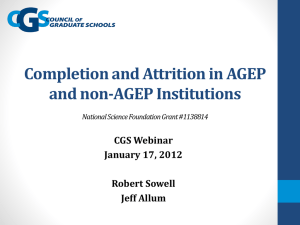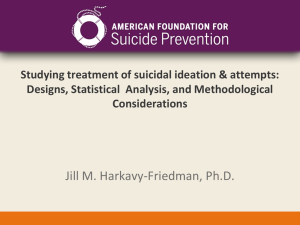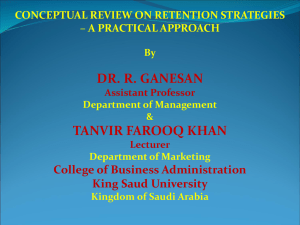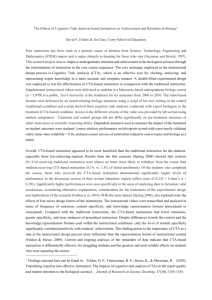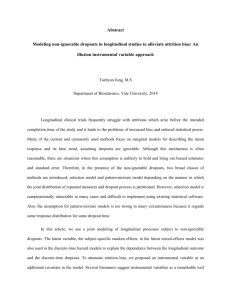Course Interactivity and Student Motivation as Factors
advertisement
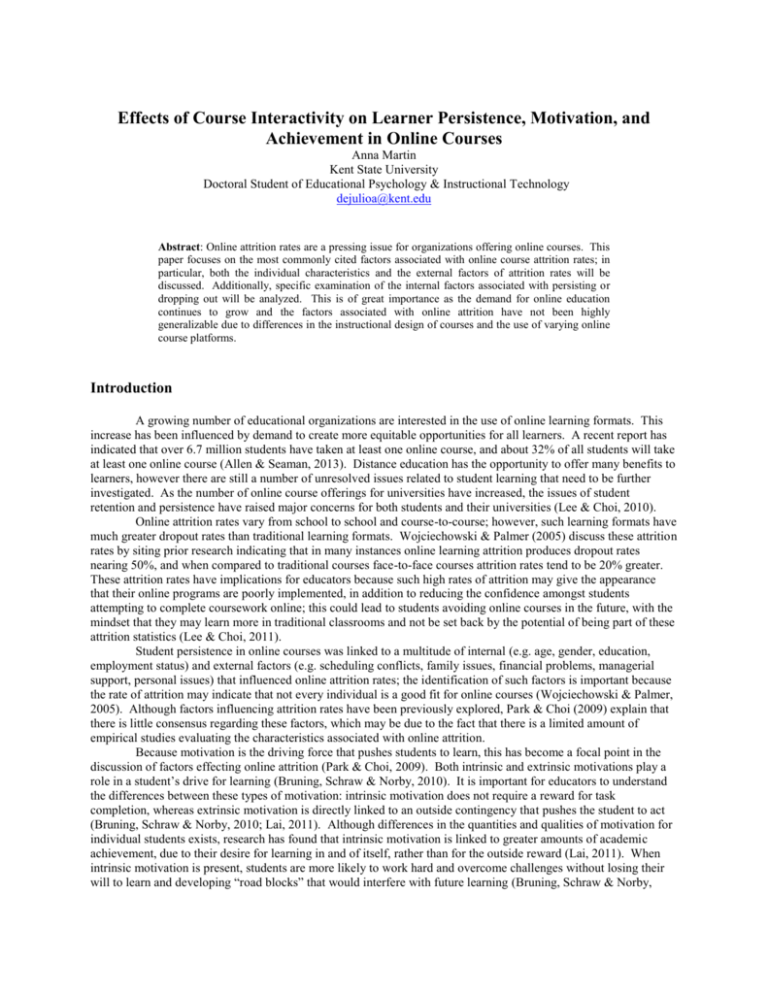
Effects of Course Interactivity on Learner Persistence, Motivation, and Achievement in Online Courses Anna Martin Kent State University Doctoral Student of Educational Psychology & Instructional Technology dejulioa@kent.edu Abstract: Online attrition rates are a pressing issue for organizations offering online courses. This paper focuses on the most commonly cited factors associated with online course attrition rates; in particular, both the individual characteristics and the external factors of attrition rates will be discussed. Additionally, specific examination of the internal factors associated with persisting or dropping out will be analyzed. This is of great importance as the demand for online education continues to grow and the factors associated with online attrition have not been highly generalizable due to differences in the instructional design of courses and the use of varying online course platforms. Introduction A growing number of educational organizations are interested in the use of online learning formats. This increase has been influenced by demand to create more equitable opportunities for all learners. A recent report has indicated that over 6.7 million students have taken at least one online course, and about 32% of all students will take at least one online course (Allen & Seaman, 2013). Distance education has the opportunity to offer many benefits to learners, however there are still a number of unresolved issues related to student learning that need to be further investigated. As the number of online course offerings for universities have increased, the issues of student retention and persistence have raised major concerns for both students and their universities (Lee & Choi, 2010). Online attrition rates vary from school to school and course-to-course; however, such learning formats have much greater dropout rates than traditional learning formats. Wojciechowski & Palmer (2005) discuss these attrition rates by siting prior research indicating that in many instances online learning attrition produces dropout rates nearing 50%, and when compared to traditional courses face-to-face courses attrition rates tend to be 20% greater. These attrition rates have implications for educators because such high rates of attrition may give the appearance that their online programs are poorly implemented, in addition to reducing the confidence amongst students attempting to complete coursework online; this could lead to students avoiding online courses in the future, with the mindset that they may learn more in traditional classrooms and not be set back by the potential of being part of these attrition statistics (Lee & Choi, 2011). Student persistence in online courses was linked to a multitude of internal (e.g. age, gender, education, employment status) and external factors (e.g. scheduling conflicts, family issues, financial problems, managerial support, personal issues) that influenced online attrition rates; the identification of such factors is important because the rate of attrition may indicate that not every individual is a good fit for online courses (Wojciechowski & Palmer, 2005). Although factors influencing attrition rates have been previously explored, Park & Choi (2009) explain that there is little consensus regarding these factors, which may be due to the fact that there is a limited amount of empirical studies evaluating the characteristics associated with online attrition. Because motivation is the driving force that pushes students to learn, this has become a focal point in the discussion of factors effecting online attrition (Park & Choi, 2009). Both intrinsic and extrinsic motivations play a role in a student’s drive for learning (Bruning, Schraw & Norby, 2010). It is important for educators to understand the differences between these types of motivation: intrinsic motivation does not require a reward for task completion, whereas extrinsic motivation is directly linked to an outside contingency that pushes the student to act (Bruning, Schraw & Norby, 2010; Lai, 2011). Although differences in the quantities and qualities of motivation for individual students exists, research has found that intrinsic motivation is linked to greater amounts of academic achievement, due to their desire for learning in and of itself, rather than for the outside reward (Lai, 2011). When intrinsic motivation is present, students are more likely to work hard and overcome challenges without losing their will to learn and developing “road blocks” that would interfere with future learning (Bruning, Schraw & Norby, 2010). Intrinsic motivation has, therefore, been the type of motivation that researchers have explored as it relates to persistence in online courses. In addition, a growing problem is that there are also a variety of platforms or learning management systems being used between universities, along with various levels of interactivity within the online courses offered. The majority of existing research compares online courses to traditional courses and provides little empirical evidence on the way in which the factors affecting online attrition differ within varying online course and instructional designs. Therefore, further analysis and understanding of online dropout rates could contribute to increased student retention in online courses. Purpose Statement and Research Questions for Future Study As a result of the existing gaps in the research this study will examine whether or not internal factors (i.e. course interactivity) impact learner persistence, situational interest and achievement in online courses. More specifically three-research questions will be tested. These questions include: (1) Do high and low levels of interactivity impact student persistence in online courses? (2) Do high and low levels of interactivity impact Situational-Interest (SI) in online courses? (3) Do learners in courses with high and low interactive qualities show significant differences in learning before and after the course? Motivational Framework in Online Attrition With an understanding that students achieve greater success in the classroom when they are intrinsically motivated to learn, this study will be approached from the Four-Phase Model of Interest Development (Hidi & Renninger, 2006). This model explains the development and deepening of interest as a factor of motivation through four phases. This progressive model moves individuals from triggered-situational interest to well-developed individual interest. Interest is an important indicator within this study as it has been closely linked to intrinsic motivation (Krapp, 2005) and an ability to help learners persist when challenged (Hidi & Renninger, 2006). Moreover, interest has also had positive effects on academic achievement across individuals and contexts (Hidi & Harackiewicz, 2000). The four-phase model of interest development suggests that interest is a psychological state and has both cognitive and affective components where the cognitive components are related to activities associated with learner engagement and the affective component being the emotions associated with student engagement (Krapp, 2005, Hidi & Renninger, 2006). Additionally, interest development depends upon the interactions learners have with both content and context (Hidi & Renninger, 2006). Hidi & Renninger (2006) explain the two types of interest that play a key role in student motivation as being “situated” and “individual” interest. Situated interest is the type of interest that is triggered by stimulus within the environment, whereas individual interest is more internally determined and tends to bring the learner back to the content across time (Hidi & Renninger, 2006). The four phases of interest development include; triggered situational interest, maintained situational interest, emerging individual interest, and well-developed individual interest. Triggered situational interest can be explained as the type of interest typically triggered by an environmental or external stimulus, which might be promoted through instructional practices. Maintained situational interest follows triggered situational interest and is interest that is sustained through environmental opportunities that provide learners with meaningful ways to engage in content. Emerging individual interest on the other hand begins the process of a learner’s desire or predisposition to reengage in the content because they have made positive associations with it. Finally, well-developed individual interest is the furthering of the previous phase, where interest becomes more likely that a learner will reengage in content because they have placed additional value on it over time; additionally, this type of interest can be deepened through the types of learning opportunities utilized during this phase. Of great importance for this particular study is the impact differing levels of interactivity have on situational interest in online courses. Situational interest focuses on the environmental conditions that have positive or negative effects on student attention and affect (Hidi & Harackiewicz, 2000). This aspect of interest is vital to learning especially when there has been little, if any individual interest established between the individual and the content, which could lead to increased engagement and ultimately a greater motivation to learn (Hidi & Harackiewicz, 2000). In direct relation to this study, situational interest has also been found to be affected by the presentation of course materials (Hidi & Harackiewicz, 2000). Although limitedly explored and compared in online settings, research has demonstrated that situational interest can be motivated by the design of educational activities and the strategies used for learning (Hidi & Renninger, 2006; Cordova & Lepper, 1996). In Cordova & Lepper’s (1996) study, researchers found that the contextualization, personalization and choice provided within learning environments utilizing computers to teach arithmetic to elementary students had significant impacts their engagement and their willingness to engage in more challenging environments in the future. In Hidi & Renninger’s (2006) model of interest development situational interest, specifically, triggered situational interest and maintain situational interest leads to greater individual interest, where greater value is placed on learning the content itself and voluntary repeat engagement in this learning is frequent. Triggered situation interest is typically externally supported and can be triggered by the established environmental learning conditions and strategies utilized (Hidi & Renninger, 2006). Maintained situational interest is elicited by triggered situational interest, this phase is also predominately externally supported and meaningful learning activities help to sustain this interest in the content and could potentially lead to the development of individual interest (Hidi & Renninger, 2006). These understanding will aid in the examination of the conditions within online courses, and the way in which situational interest can be triggered and specifically externally supported through the environmental conditions established in the online course. These conditions may be built within the online learning management system being used and/or the designed amount of interactivity within the course. With a better understanding of the way in which students are motivated in online courses, universities will have a better chance of curbing high attrition rates through increased persistence. Factors Potentially Influencing Online Attrition Rates At this point, research on online learning attrition has not been highly generalizable; however, the most commonly cited reasons for the increase in attrition amongst online offerings include individual learner characteristics and external and internal factors. Individual characteristics include factors like a learner’s age, gender, and level of education. External factors account for the support structures available to learners, such as family and instructor support, while internal factors account for the personal attributes of students, such as student motivation and instructional design (Park & Choi, 2009). The individual characteristics associated with student dropout rates are the personal characteristics students bring with them to the classroom; these personal characteristics precede the class itself. Park & Choi (2009) conducted a study to evaluate the way in which these factors effect a student’s decision to drop out of an online course at a large Midwestern university. In this study, researchers found no statistical difference between students’ individual characteristics and their likelihood to drop out (p = .147); however, even without a statistically significant difference, this does not mean these characteristics should be entirely ignored (Park & Choi, 2009; Park, Lee, & Kim, 2013). These factors should not be ignored entirely because individual characteristics can influence success or the degree of that success in online courses, however when they are indicators of success they have been typically linked to prior knowledge and preparation. In a study tracking a large data set of 51,017 students at 34 different community colleges in Washington State, Xu & Jaggars (2013) compared the students’ individual characteristics and course delivery format to gain a better understanding of the effect they had on course persistence and learning outcomes. Researchers found that across the board all subgroups had negative coefficients for online learning and persistence; however males, Blacks, and those with a lack of college preparation were more likely to dropout or have greater negative impacts on their course grade (Xu & Jaggars, 2013). External factors involving the support provided within the family as well as by the instructor are also commonly cited factors associated with increased attrition in online courses. Although examining the attrition process for face-to-face courses, Bean & Metzner (1985) begin the discussion of the differences between traditional and nontraditional students and the factors affecting their decisions to persist or dropout. A meta-analysis was used to develop a model of this attrition process, in which they found the greatest difference between these two groups of students was the impact external environmental variables had on nontraditional students (Bean & Metzner, 1985). Recent empirical research in online attrition rates associated with external factors still tends to be inconsistent across studies. Park & Choi (2009) conducted a study examining 147 learners in online job-related courses at a large Midwestern University. The goal of this study was to determine how persistent learners differ from dropouts in online courses in regard to their individual, external, and internal factors. The external factors of family and organizational support demonstrated statistically significant results between groups (p < .05). Alternatively, in a similar study examining the same five factors associated with student persistence and attrition (i.e. support from family and work, academic locus of control, academic self-efficacy, time and environment management skills, and metacognitive self-regulation skills), Park, Lee, & Kim (2013) examined the way in which 169 students majoring in education in a Korean university differed in persistence. In regard to the external factors evaluated (i.e. level of family and work support) a MANOVA revealed no statistically significant differences (p = 0.997). Student Motivation and Online Attrition Rates Student motivation is one of, if not the most, commonly cited factor associated with online persistence and dropout rates. This is primarily because while every student can potentially be motivated by different intrinsic and extrinsic factors, not all students are motivated in the same way. Due to the varying levels of motivation between students, educators are constantly looking for learning strategies that will motivate students to persist in online environments that tend to have higher rates of attrition than traditional environments. Motivation may potentially be one of the most important characteristics to examine because it is a characteristic that can be obstructed by the other individual characteristics or other both internal and external factors (Giani & O’Guinn, 2010). Lee & Choi, leaders in recent research regarding online attrition rates, have frequently examined the internal factors associated with the increased dropout rates for such courses. In a recent study involving 282 students, Lee & Choi, examined four variables, including internal academic locus of control (ALOC), learning strategies, flow experience, and student satisfaction. Structural Equation Modeling (SEM) found statistically significant effects for the variables of internal ALOC and retention (p = .004), satisfaction and retention (p = .003), internal ALOC and satisfaction (p = .003), flow and satisfaction (p < .01), and learning strategies and flow (p = .041) (Lee & Choi, 2013). The examination of a student’s locus of control is vital in understanding student motivation, as a strong locus of control has been linked to greater “self-efficacy” or attitude towards their ability to complete a task. In this instance, the researchers found that having an internal locus of control led to increased satisfaction with online courses and a decreased chance of dropping out; however, a major piece missing from this particular study is actual retention data, as only the intent of students to persist was measured. Lee, Choi, and Kim (2013) further researched the connections between student motivation and attrition by investigating five factors: “(1) time and study environment management, (2) metacognitive self-regulation, (3) academic self-efficacy, (4) academic locus of control and (5) support from family and work” (p. 322). Examination of such factors took place in an online course offered to undergraduate students in education involving 169 participants at a Korean university. The research provides additional information to the field by breaking down important characteristics associated with student motivation and their impacts on attrition in online courses. Most significantly, this study concluded in an overall analysis of significant results that academic locus of control (p < 0.05) and metacognitive self-regulation (p = 0.012) were most influential in determining persistence and attrition between groups (Lee, Choi, & Kim, 2013). Although the population examined in this study is not highly generalizable to U.S. students, the researchers make an important contribution to online attrition rates by providing evidence for practical application. Additionally, limited research exists on the components of the motivational variable of student interest and the effects it could have on student engagement and persistence in online learning environments. In a study conducted by Sun & Rueda (2012) they examined 203 students’ levels of situational interest, self-efficacy and selfregulation and their effects on student engagement in online and blended courses in the schools of Gerontology and Engineering. Interestingly, interest was the only motivational variable with significance related to emotional engagement (p < .001), however, interest at the bivariate level affected all three types of engagement, which also included behavioral and cognitive engagement. Therefore, it is important for educators to include instructional tools to improve student interest, however these tools alone may not have an effect on students behavioral and cognitive engagement, thus making instructional design particularly important (Sun & Rueda, 2012). This is one of the few studies examining situational interest in relation to online courses, however additional research is necessary to determine its effect on instructional design and attrition. Instructional Design and Online Attrition Rates Further elaboration on the design of online courses is necessary, as student motivation is often linked to instructional design (Roblyer & Wiencke, 2010). The level of student engagement in learning is a necessary factor for motivation. Student engagement deals with the level at which students are attentive and focused on the learning task. This factor is extremely important in fostering a students desire to be active participants in the learning process. Student engagement is key to motivation and academic success, although individual students vary in their quantities and qualities of motivation given the context. (Saeed & Zyngier, 2012). Helping to encourage intrinsic motivation tends to increase the likelihood of students willingness to persist in challenging situation and has been linked to greater amounts achievement (Giani & O’Guinn). Additionally, students tend to have greater amounts of academic success when they have an implicit desire to learn and the context in which learning occurs is safe and allows for students to learn from their errors (Giani & O’Guinn). To a degree, all of these characteristics can be controlled by the teachers themselves through deliberate content and course design, which ultimately may motivate students and reduce attrition in online courses. Wentzel & Wigfield (1998) examined existing research regarding academic and social motivation and their influence on student performance. In their summation they explain instructors can play a major role in the social indicators of student motivation through the deliberate creation of instructional practices and the way in which they create interpersonal interactions within their courses (Wentzel & Wigfield, 1998). A key piece of student motivation has been linked to the socialization that takes place with the students’ teachers and peers. For instance, clear communication about academic expectations and goals can positively impact student learning. The ability of teachers to differentiate instruction and make it relatable to the differing abilities and interests of students also plays a role in the level of motivation a student may experience in an individual class. These factors have been most commonly associated with traditional courses but can be applied to the internal factors most frequently cited with the rise in online attrition. For instance, in Park & Choi’s (2009) study found that satisfaction (p < .05) and relevance (p < .05) were statistically significant between those learners choosing to dropout or persist. More recently, Lim, Morris, and Kupritz (2014) compared a blended course design to a completely online-based course in order to identify differences in learning outcomes and in instructional and learner factors. Interestingly, out of the 126 undergraduates from the University of Tennessee participating in the study, there were no significant differences between course format and learning outcomes, however the most significant and applicable finding in this study indicated that both groups showed the most important factors influencing their learning was having “clear and concise learning content” (p. 32), along with the level of support provided in the course” (p. 31). Researchers additionally found that 76% of participants perceived group and individual projects as being the most helpful instructional activities, while another 47% of participants perceived discussion activities as being of the most helpful aspects of these online course formats. These results correspond with previous research that indicates effective instructional design has the potential to increase student motivation and success in online courses. Similarly, Kui (2013) examined how student motivation and peer feedback might impact learning behavior in online course discussions. Kui’s study focuses on the correlation between student motivation, peer feedback and student posting and non-posting activity in an online course. Kui found that students’ posting and non-posting behaviors in online courses were significantly linked to a student’s sense of confidence and, therefore, their likelihood to engage in online courses leading to increased success. This was evident in the significant effects the motivational and peer feedback variables had on student’s online discussion behaviors (e.g. number of poses, length of post, number of topics read, number of ratings given, number of logins without posting, length of logins without posting; p < .00). Similarly, the study indicated that peer feedback also had significant effects on students’ motivation, which was indicated in multiple regression analyses identifying significance for intrinsic motivation (p = .001), autonomy (p < .01), competence (p < .001) and relatedness (p < .01). This is significant because it implies that teachers can have an impact on student motivation and engagement through their design and organization of the online course (Kui, 2013). Many of these characteristics have been condensed into a rubric that characterizes the differences between “high” and “low” interactive online courses. Roblyer & Ekhaml (2000), developed a rubric that can be used by both students and instructors to help categorize the level of interactivity in an online course through the evaluation of four specific variables related to the social goals of interaction, the instructional goals of interaction, the types and uses of technologies, and the impact of interactivity changes in learner behaviors. These variables have been based on the prior definition of the term interaction as it relates to online courses, which Roblyer & Wiencke (2010) explain is based on three factors: First, it is apparent that interaction is achieved through a complex interplay of social, instructional, and technological variables. Second, though influenced by all these factors, the aspect of interaction acknowledged to be most meaningful to instructors and designers in student engagement in the learning process. Third, student engagement can be increased when learning is structured around collaborative experiences (p. 86). An updated rubric more relevant to current characteristics in online learning has identified that high interactive courses on the rubric tend to receive a score of 18-25 points, moderately interactive courses tend to receive a score of 10-17 points, and courses with low interactivity receive scores between 1-9 points on the rubric (Roblyer & Wiencke, 2010). Because of the physical distance inherent in distance education courses this rubric will be used to identify whether or not differences in instructional design impact online learning motivation and persistence in online environments. Conclusions and Implications Limitations Research is clear in that there are specific factors that influence online attrition rates, yet the research is unclear in determining which factors are most significantly affecting student attrition. In addition, the largest gap in the research appears to be the fact that online learning studies that examine student attrition tend to be compared to face-to-face courses, which ignores the differing designs of other completely online courses within and across schools. As noted by Park & Choi (2009), “[o]nline learners can easily lose motivation unless the course is designed to stimulate their active participation and interaction and meet their expectations. Therefore, an online course needs to be designed in ways that guarantee learners’ satisfaction and be relevant to learners’ needs” (p. 216). Because of the limited amount of research focused on the relations between student motivation, online instructional design, and attrition rates, further investigation is necessary in this field. References: Allen, I. E., & Seaman, J. (2013). Changing Course: Ten Years of Tracking Online Education in the United States. Sloan Consortium. PO Box 1238, Newburyport, MA 01950. Bean, J. P., & Metzner, B. S. (1985). A conceptual model of nontraditional undergraduate student attrition. Review of Educational Research, 55(4), 485-540. Bruning, R. H., Schraw, G. J., & Norby, M. N. (2010). Cognitive Psychology and Instruction (5thedition), Pearson Merrill Prentice Hall. Deci, E. L., Vallerand, R. J., Pelletier, L. G., & Ryan, R. M. (1991). Motivation and education: The selfdetermination perspective. Educational psychologist, 26(3-4), 325-346. Dede, C. (2004). Implications for investments in technology and faculty. Retrieved from http://cfcc.edu/SACS/QEP/documents/PlanningforNeomillenniallearningstylesDede2004.pdf Giani, M. S., & O’Guinn, C. M. Motivation to Learn: Igniting a Love of Learning in All Students. Kui, X. (2013). What do the numbers say? The influence of motivation and peer feedback on students' behaviour in online discussions. British Journal Of Educational Technology, 44(2), 288-301. doi:10.1111/j.14678535.2012.01291 Lee, Y., & Choi, J. (2011). A review of online course dropout research: implications for practice and future research. Educational Technology Research and Development, 59(5), 593-618. Lee, Y., & Choi, J. (2013). A structural equation model of predictors of online learning retention. The Internet and Higher Education, 16, 36-42. Lee, Y., Choi, J., & Kim, T. (2013). Discriminating factors between completers of and dropouts from online learning courses. British Journal of Educational Technology, 44(2), 328-337. Liu, S., Gomez, J., Khan, B. & Yen, C.J. (2007). Toward a Learner-Oriented Community College Online Course Dropout Framework. International Journal on E-Learning, 6(4), 519-542. Chesapeake, VA: AACE. Park, J. H., & Choi, H. J. (2009). Factors Influencing Adult Learners' Decision to Drop Out or Persist in Online Learning. Educational Technology & Society, 12(4), 207-217. Roblyer, M. D., & Ekhaml, L. (2000). How interactive are your distance courses? A rubric for assessing interaction in distance learning. Online Journal of Distance Learning Administration, 3(2). Roblyer, M. D., & Wiencke, W. R. (2004). Exploring the interaction equation: Validating a rubric to assess and encourage interaction in distance courses. Journal of Asynchronous Learning Networks, 8(4), 24-37. Saeed, S., Zyngier, D. (2012). How motivation influences student engagement: A qualitative case study. Journal of Education and Learning 1(2). Tinto, V. (1975). Dropout from higher education: A theoretical synthesis of recent research. Review of educational research, 89-125. Wojciechowski, A., & Palmer, L. B. (2005). Individual student characteristics: Can any be predictors of success in online classes?. Online Journal of Distance Learning Administration, 8(2). Xu, D., & Jaggars, S. (2013). Adaptability to online learning: Differences across types of students and academic subject areas.



